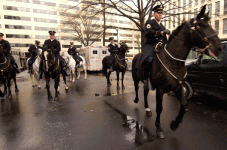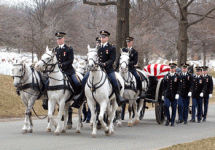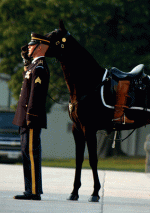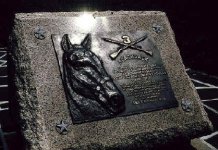♘امیرحسین♞
♘ مدیریت انجمن اسب ایران ♞
The silence of the procession is broken only by the rhythmic clip-clop of the seven handsome horses. Astride four of the horses, soldiers sit ramrod straight and stiff. The horses, head erect, bodies taut and controlled, seem to initiate the solemn military bearing of the men who sit quietly in the saddles.
Six of the horses pull a flag draped casket on a black artillery caisson. Both men and horses are conscious that this is no ordinary ride through a cool, shady country lane. They have the honor of carrying a comrade for his last ride to Arlington National Cemetery, where he will rest in peace with other honored dead.
The solemn dignity which the men and horses lend to this ceremony is neither accidental or instinctive. Both men and horses train constantly for this duty. They are members of the Caisson platoon of the 3d United States Infantry (The Old Guard).
Most of these men come to Ft. Myer, Virginia not as expert horseman, but as trained infantrymen. A new man on this team must undergo rigorous training. In addition to caring for the horses, he must learn to ride at the erect posture of solemn military attention in a military forward position and sitting in a McClellan saddle.
The horses come to the Old Guard primarily from Illinois, Virginia, Texas and Maryland, as well as other states.
Although they are normally "saddle broken" before their arrival at Ft. Myer, they require extensive additional training to work with the caisson. Consequently, horse and rider drill, train and live together until both are deemed qualified to accomplish their mission.
The caissons were built in 1918, and used for 75mm cannons. They were originally equipped with ammunition chests, spare wheels, and tools used for the cannons. Today these have been removed and replaced with the flat deck on which the casket rests.
The six horses which pull the caisson through the quiet lanes of Arlington National Cemetery are matched gray or black. They are paired into three teams – the lead team is in front, the swing team follows, and nearest the caisson is the wheel team. Although all six animals are saddled, only those on the left have mounted riders. This is a tradition which began in the early horse-drawn artillery days when one horse of each team was mounted while the other carried provisions and feed.
In addition to their duties in military funerals, the Caisson Platoon participates in numerous historic pageants performed by the Old Guard, among these are "Spirit of America", and "Twilight Tattoo".
The Lipizzans
On June 9, 1981, ten Lipizzan horses were donated to the Caisson Platoon. The horses were accepted on behalf of the Army by the Secretary of the Army John O. Marsh, Jr., during a ceremony at Summerall Field, Fort Myer, Virginia. The Lipizzans are used to make up the "White Horse Team" for use in military funerals in Arlington National Cemetery.
Famed for their grace, intelligence and great strength, they were a lead element in the inaugural parade for President Ronald Reagan and Vice President George Bush.
The Lipizzan matures slowly. It is born dark in color, begins to turn gray at about four years of age, and silvery gray between seven and ten years of age. It is not usual for a Lipizzan to live past 30 years of age.
The Riderless Horse
One of the oldest and most evocative of military traditions in a full honor funeral is that of the riderless, caparisoned horse. The horse is led behind the caisson wearing an empty saddle with the riders boots reversed in the stirrups. This indicates the warrior will never ride again.
Tradition allows a caparisoned horse to follow the casket at any Army or Marine Corps commissioned officer in the rank colonel or above. Presidents of our nation, as Commander in Chief, are accorded the same honor. Over the years millions have witnessed caissons bearing the flag draped caskets of Franklin D. Roosevelt, Herbert Hoover, Douglas MacArthur, John F. Kennedy, Dwight D. Eisenhower, and Lyndon B. Johnson.. In each ceremony the caisson was followed by the caparisoned horse involved in the internment of each Unknown Soldier as well.
"Black Jack"
The Caisson Platoon has been the home of the Army’s oldest and most famous horse – "Black Jack," foaled January 19, 1947, and coming to Ft. Myer from Fort Reno, Oklahoma, on November 22nd, 1952. "Black Jack" had the honor of being named after general of the Armies John J. "Black Jack" Pershing.
"Black Jack" was the last of the Quartermaster – issue horses branded with the Armies U.S. brand (on the left shoulder} and his Army serial number 2V56 (on the left side of his neck).
"Black Jack" has taken part not only in funerals of Presidents John F. Kennedy, Herbert Hoover, Lyndon B. Johnson, and General Douglas MacArthur. but literally thousands of others in Arlington Cemetery during his 24 years of service with the Old Guard.
"Black Jack" ended his dedicated, dignified military career on February 6, 1976, and buried on the parade ground of Fort Myer's Summerall Field.
Six of the horses pull a flag draped casket on a black artillery caisson. Both men and horses are conscious that this is no ordinary ride through a cool, shady country lane. They have the honor of carrying a comrade for his last ride to Arlington National Cemetery, where he will rest in peace with other honored dead.
The solemn dignity which the men and horses lend to this ceremony is neither accidental or instinctive. Both men and horses train constantly for this duty. They are members of the Caisson platoon of the 3d United States Infantry (The Old Guard).
Most of these men come to Ft. Myer, Virginia not as expert horseman, but as trained infantrymen. A new man on this team must undergo rigorous training. In addition to caring for the horses, he must learn to ride at the erect posture of solemn military attention in a military forward position and sitting in a McClellan saddle.
The horses come to the Old Guard primarily from Illinois, Virginia, Texas and Maryland, as well as other states.
Although they are normally "saddle broken" before their arrival at Ft. Myer, they require extensive additional training to work with the caisson. Consequently, horse and rider drill, train and live together until both are deemed qualified to accomplish their mission.
The caissons were built in 1918, and used for 75mm cannons. They were originally equipped with ammunition chests, spare wheels, and tools used for the cannons. Today these have been removed and replaced with the flat deck on which the casket rests.
The six horses which pull the caisson through the quiet lanes of Arlington National Cemetery are matched gray or black. They are paired into three teams – the lead team is in front, the swing team follows, and nearest the caisson is the wheel team. Although all six animals are saddled, only those on the left have mounted riders. This is a tradition which began in the early horse-drawn artillery days when one horse of each team was mounted while the other carried provisions and feed.
In addition to their duties in military funerals, the Caisson Platoon participates in numerous historic pageants performed by the Old Guard, among these are "Spirit of America", and "Twilight Tattoo".
The Lipizzans
On June 9, 1981, ten Lipizzan horses were donated to the Caisson Platoon. The horses were accepted on behalf of the Army by the Secretary of the Army John O. Marsh, Jr., during a ceremony at Summerall Field, Fort Myer, Virginia. The Lipizzans are used to make up the "White Horse Team" for use in military funerals in Arlington National Cemetery.
Famed for their grace, intelligence and great strength, they were a lead element in the inaugural parade for President Ronald Reagan and Vice President George Bush.
The Lipizzan matures slowly. It is born dark in color, begins to turn gray at about four years of age, and silvery gray between seven and ten years of age. It is not usual for a Lipizzan to live past 30 years of age.
The Riderless Horse
One of the oldest and most evocative of military traditions in a full honor funeral is that of the riderless, caparisoned horse. The horse is led behind the caisson wearing an empty saddle with the riders boots reversed in the stirrups. This indicates the warrior will never ride again.
Tradition allows a caparisoned horse to follow the casket at any Army or Marine Corps commissioned officer in the rank colonel or above. Presidents of our nation, as Commander in Chief, are accorded the same honor. Over the years millions have witnessed caissons bearing the flag draped caskets of Franklin D. Roosevelt, Herbert Hoover, Douglas MacArthur, John F. Kennedy, Dwight D. Eisenhower, and Lyndon B. Johnson.. In each ceremony the caisson was followed by the caparisoned horse involved in the internment of each Unknown Soldier as well.
"Black Jack"
The Caisson Platoon has been the home of the Army’s oldest and most famous horse – "Black Jack," foaled January 19, 1947, and coming to Ft. Myer from Fort Reno, Oklahoma, on November 22nd, 1952. "Black Jack" had the honor of being named after general of the Armies John J. "Black Jack" Pershing.
"Black Jack" was the last of the Quartermaster – issue horses branded with the Armies U.S. brand (on the left shoulder} and his Army serial number 2V56 (on the left side of his neck).
"Black Jack" has taken part not only in funerals of Presidents John F. Kennedy, Herbert Hoover, Lyndon B. Johnson, and General Douglas MacArthur. but literally thousands of others in Arlington Cemetery during his 24 years of service with the Old Guard.
"Black Jack" ended his dedicated, dignified military career on February 6, 1976, and buried on the parade ground of Fort Myer's Summerall Field.




